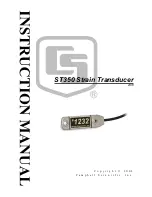
05-2806A01, Rev. J
iNET Series Reference Manual
61
2.6 CONFIGURING THE SERIAL
PORTS
2.6.1 Overview
The transceiver includes an embedded serial device server that provides
transparent encapsulation over IP. In this capacity, it acts as a gateway
between serial and IP remote devices. Two common scenarios are PC
applications using IP to talk to remote devices, and serial PC applica-
tions talking to remote serial devices over an IP network.
Essentially the same data services are available for both serial ports:
COM1
and
COM2
. Note that the transceiver’s
COM1
port is DCE and
COM2
is DTE. Therefore, if the RTU to be connected is also DTE, then
a null-modem cable will need to be used when connecting to
COM2
.
NOTE:
In the discussion that follows,
COM1
and
COM2
will be treated
alike unless noted.
Com1 Port
–Dual Purpose Capability
The COM1 port is used as a local console connection point and to pass
serial data with an external device. Setting the
COM1
port status to
Enable
prevents access to the Management System (MS) through this port.
However, the MS can still be accessed via the LAN port using Telnet or
a web browser.
To restore the COM1 port to support Management System services,
connect a terminal to the port, select the proper baud rate (19,200 is
default), and enter an escape sequence (
+++
) to reset it to the console
mode.
TCP vs. UDP
Both types of IP services are used by the transceiver embedded serial
device server—TCP and UDP. TCP provides a connection-oriented link
with end-to-end acknowledgment of data, but with some added over-
head. UDP provides a connectionless best-effort delivery service with
no acknowledgment.
Most polled protocols will be best served by UDP service as the protocol
itself has built-in error recovery mechanisms. UDP provides the needed
multidrop operation by means of multicast addressing.
On the other hand, TCP services are best suited for applications that do
not have a recovery mechanism (error-correction) and must have the
guaranteed delivery that TCP provides despite the extra overhead. The
IP-to-Serial example shows how to do this. (See
“
IP-to-Serial Applica-
tion Example” on Page 72.)
Summary of Contents for MDS iNET 900
Page 12: ...2 iNET Series Reference Manual 05 2806A01 Rev J ...
Page 32: ...22 iNET Series Reference Manual 05 2806A01 Rev J ...
Page 122: ...112 iNET Series Reference Manual 05 2806A01 Rev J ...
Page 134: ...124 iNET Series Reference Manual 05 2806A01 Rev J ...
Page 136: ...126 iNET Series Reference Manual 05 2806A01 Rev J ...
Page 160: ...150 iNET Series Reference Manual 05 2806A01 Rev J ...
Page 162: ...152 iNET Series Reference Manual 05 2806A01 Rev J ...
Page 172: ...162 iNET Series Reference Manual 05 2806A01 Rev J ...
Page 180: ...170 iNET Series Reference Manual 05 2806A01 Rev J ...
Page 186: ...I 6 iNET Series Reference Manual 05 2806A01 Rev J ...
















































